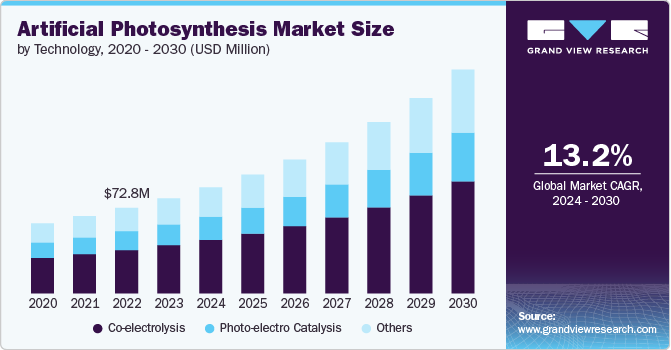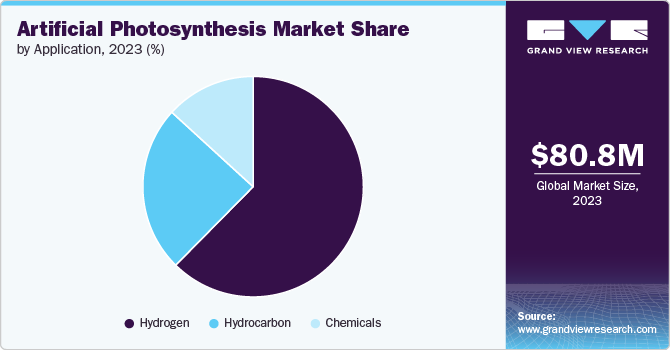- Home
- »
- Renewable Energy
- »
-
Artificial Photosynthesis Market Size And Share Report, 2030GVR Report cover
![Artificial Photosynthesis Market Size, Share & Trends Report]()
Artificial Photosynthesis Market Size, Share & Trends Analysis Report By Technology (Co-electrolysis, Photo-electro Catalysis), By Application (Hydrocarbon, Hydrogen), By Region, And Segment Forecasts, 2024 - 2030
- Report ID: GVR-4-68040-412-2
- Number of Report Pages: 85
- Format: PDF, Horizon Databook
- Historical Range: 2018 - 2022
- Forecast Period: 2024 - 2030
- Industry: Energy & Power
“2030 artificial photosynthesis market value to reach USD 190.0 million.”
Artificial Photosynthesis Market Trends
The global artificial photosynthesis market size was estimated at USD 80.8 million in 2023 and is estimated to grow at a CAGR of 13.2% from 2024 to 2030. Global focus on reductions of carbon emissions is expected to remain a key driver for the market.

With climate change becoming a critical concern, the demand for innovative and sustainable solutions to produce clean energy is expected to rise over the coming years. Artificial photosynthesis mimics the natural process of photosynthesis, offering a green technology to capture carbon dioxide from the atmosphere and convert it into useful fuels and chemicals, thereby directly addressing the need for carbon-neutral or even carbon-negative energy sources.
Drivers, Opportunities & Restraints
Increasing focus on energy security and the diversification of energy sources is likely to remain a key focusing area for market participants. As different governments seek to reduce their dependence on fossil fuels and mitigate the risks associated with geopolitical tensions and supply disruptions, artificial photosynthesis presents an attractive substitute. It utilizes abundant resources like sunlight, water, and carbon dioxide, promising a steady, sustainable, and domestic source of energy, which contributes to energy independence and security.
Artificial photosynthesis has the potential to revolutionize sectors beyond just energy production, including chemicals, pharmaceuticals, and agriculture. For instance, the ability to produce carbon-neutral fuels and high-value chemicals from CO2 can transform the chemical manufacturing industry, reducing its carbon footprint and reliance on petrochemicals. Additionally, this technology is expected to contribute to innovative applications in creating sustainable materials and even in carbon capture and storage techniques, offering new opportunities for growth and development.
The market is likely to be affected by the high cost and technical challenges associated with the development and commercial scale-up. The efficiency of artificial photosynthesis devices in converting sunlight into energy or chemicals still falls short when compared to natural photosynthesis or existing renewable technologies like solar photovoltaics. Additionally, substantial investments in research, development, and commercialization are required to overcome these hurdles and make artificial photosynthesis a viable and competitive option in the global energy market.
Technology Insights
“Co-electrolysis technology held the largest revenue share of over 50% in 2023.”
Co-electrolysis technology is expected to gain momentum due to its promising applications in sustainable energy generation. Co-electrolysis is a process that involves the electrochemical conversion of water and carbon dioxide into valuable chemicals and fuels, mimicking natural photosynthesis but at a much faster rate. This technology segment is particularly attractive for its potential to produce hydrogen, a clean and sustainable energy carrier, alongside other carbon-based fuels and chemicals.
Photo-electro catalysis process involves the use of photo-electrochemical cells that absorb sunlight and initiate a chemical reaction to split water molecules into oxygen and hydrogen, the latter being a valuable clean energy carrier. Ongoing advancements in nanotechnology and materials science are enhancing the efficiency and durability of photo-electrocatalytic systems. With a growing interest in renewable energy sources and the global drive toward decarbonization, the photo-electro catalysis segment is expected to observe substantial growth.
Application Insights
“Hydrogen application held the largest revenue share of over 62% in 2023.”
Hydrogen produced through artificial photosynthesis can be used in fuel cells for electricity generation or as a direct fuel source for transportation and industrial processes. The segment growth is driven by the global demand for sustainable and environmentally friendly energy solutions. With its multiple benefits of sustainability and versatility, hydrogen produced via artificial photosynthesis could play a crucial role in the future energy landscape, marking a shift toward more sustainable and clean energy sources.

Hydrocarbon application focuses on the creation of hydrocarbons through artificial photosynthesis processes, mirroring natural photosynthesis but with an output aimed at generating usable fuels. Hydrocarbon has potential to produce sustainable, clean energy sources that could replace conventional fossil fuels. By converting solar energy directly into hydrocarbons, technologies in this area can significantly reduce carbon footprints and contribute to combatting climate change.
Regional Insights
“North America held over 33% revenue share of the overall artificial photosynthesis market.”
North America artificial photosynthesis market is expected to grow on account of the region's strong emphasis on renewable energy sources and sustainable technology development. North American universities and research institutions are at the forefront of artificial photosynthesis technology, working on breakthrough methods to convert carbon dioxide into organic compounds, leveraging sunlight. This is expected to boost the green energy sector along with promises to transform CO2 emission challenges into renewable energy opportunities.
U.S. Artificial Photosynthesis Market Trends
The artificial photosynthesis market in the U.S. is growing as the Department of Energy, through its various research arms, notably the Joint Center for Artificial Photosynthesis (JCAP), has made significant strides in advancing artificial photosynthesis technologies. The focus is not only on enhancing the efficiency of converting sunlight, water, and carbon dioxide into fuel but also on making the technology economically viable for widespread use.
Europe Artificial Photosynthesis Market Trends
The artificial photosynthesis market in Europe is expected to show a robust commitment toward reducing carbon footprints and enhancing green energy production, with artificial photosynthesis playing a pivotal role. Countries such as Germany, the UK, and the Netherlands are integrating artificial photosynthesis in strategic energy plans and fostering partnerships between academia and industry to accelerate development and deployment.
Asia Pacific Artificial Photosynthesis Market Trends
The artificial photosynthesis market in Asia Pacific is expected to observe a rapid growth, fueled by escalating energy demands and environmental concerns. Countries like China, Japan, and South Korea are investing heavily in research and development. This region's commitment to sustainable innovation positions it as a promising region in the world.
Key Artificial Photosynthesis Company Insights
Some of the key players operating in market include Panasonic Corporation, Toyota Central R&D Labs., Inc., and FUJITSU.
-
Panasonic Corporation is a Japan-based multinational company that operates in diverse domains ranging from consumer electronics to renewable energy solutions. The company focused on solar energy and battery technologies, aligning with its vision for a greener and more connected world.
-
Toyota Central R&D Labs., Inc. focused on automotive research and development. It is also looking to expand cutting-edge technologies such as hydrogen fuel cell vehicles to advancements in artificial intelligence and robotics.
Key Artificial Photosynthesis Companies:
The following are the leading companies in the artificial photosynthesis market. These companies collectively hold the largest market share and dictate industry trends.
- Panasonic Corporation
- ENGIE
- Siemens Energy
- Mitsubishi Chemical Corporation
- Toshiba Corporation
- FUJITSU
- FUJIFILM Corporation
- Toyota Central R&D Labs., Inc.
- Twelve
Recent Developments
-
In February 2024, researchers from Osaka Metropolitan University created new artificial photosynthesis system which can produce fumaric acid with double yield compared with previous system.
-
In November 2022, six chemists from University of Chicago created a new system for artificial synthesis that is more powerful than previous version. This system can produce methane, ethanol and other fuels from carbohydrates.
Artificial Photosynthesis Market Report Scope
Report Attribute
Details
Market size value in 2024
USD 90.1 million
Revenue forecast in 2030
USD 190.0 million
Growth Rate
CAGR of 13.2% from 2024 to 2030
Base year for estimation
2023
Historical data
2018 - 2022
Forecast period
2024 - 2030
Quantitative Units
Revenue in USD million/billion, and CAGR from 2024 to 2030
Report coverage
Revenue forecast, competitive landscape, growth factors, and trends
Segments covered
Technology, application, region
Regional scope
North America, Europe, Asia Pacific, Central & South Africa, Middle East, Africa
Country scope
U.S., Canada, Mexico, Germany, UK, Russia, China, India, Japan, South Korea, Brazil, GCC, South Africa
Key companies profiled
Panasonic Corporation, ENGIE, Siemens Energy, Mitsubishi Chemical Corporation, Toshiba Corporation, FUJITSU, FUJIFILM Corporation, Toyota Central R&D Labs., Inc., and Twelve
Customization scope
Free report customization (equivalent up to 8 analysts working days) with purchase. Addition or alteration to country, regional & segment scope.
Pricing and purchase options
Avail customized purchase options to meet your exact research needs. Explore purchase options
Global Artificial Photosynthesis Market Report Segmentation
This report forecasts revenue growth at global, country, and regional levels and provides an analysis of the latest industry trends in each of the sub-segments from 2018 to 2030. For this study, Grand View Research has segmented the global artificial photosynthesis market report on the basis of technology, application, and region.
-
Technology Outlook (Revenue, USD Million, 2018 - 2030)
-
Co-electrolysis
-
Photo-electro catalysis
-
Others
-
-
Application Outlook (Revenue, USD Million, 2018 - 2030)
-
Hydrocarbon
-
Hydrogen
-
Chemicals
-
-
Regional Outlook (Revenue, USD Million, 2018 - 2030)
-
North America
-
U.S.
-
Canada
-
Mexico
-
-
Europe
-
Germany
-
UK
-
Russia
-
-
Asia Pacific
-
China
-
India
-
Japan
-
South Korea
-
-
Central & South America
-
Brazil
-
-
Middle East & Africa
-
GCC
-
South Africa
-
-
Frequently Asked Questions About This Report
b. The global artificial photosynthesis market size was estimated at USD 80.8 million in 2023 and is expected to reach USD 90.1 million in 2024.
b. The global artificial photosynthesis market is expected to grow at a compound annual growth rate of 13.2% from 2024 to 2030 to reach USD 190.0 million by 2030.
b. By application, hydrogen dominated the market with a revenue share of over 62.0% in 2023.
b. Some of the key vendors of the global artificial photosynthesis market are Panasonic Corporation, ENGIE, Siemens Energy, Mitsubishi Chemical Corporation, Toshiba Corporation, FUJITSU, FUJIFILM Corporation, Toyota Central R&D Labs., Inc., and Twelve
b. The key factor driving the growth of the increasing need for growing R&D investments in the market and rising need for energy around the world
Share this report with your colleague or friend.
![gvr icn]()
NEED A CUSTOM REPORT?
We can customize every report - free of charge - including purchasing stand-alone sections or country-level reports, as well as offer affordable discounts for start-ups & universities. Contact us now
![Certified Icon]()
We are GDPR and CCPA compliant! Your transaction & personal information is safe and secure. For more details, please read our privacy policy.
We are committed towards customer satisfaction, and quality service.
"The quality of research they have done for us has been excellent."





